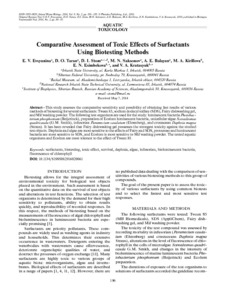Comparative assessment of toxic effects of surfactants using biotesting methods
Скачать файл:
URI (для ссылок/цитирований):
https://elib.sfu-kras.ru/handle/2311/33146Автор:
Evsyunina, E. V.
Taran, D. O.
Stom, D. I.
Saksonov, M. N.
Balayan, A. E.
Kirillova, M. A.
Esimbekova, E. N.
Kratasyuk, V. A.
Коллективный автор:
Институт фундаментальной биологии и биотехнологии
Кафедра биофизики
Дата:
2016Журнал:
Inland Water BiologyКвартиль журнала в Scopus:
Q4Квартиль журнала в Web of Science:
Q4Библиографическое описание:
Evsyunina, E. V. Comparative assessment of toxic effects of surfactants using biotesting methods [Текст] / E. V. Evsyunina, D. O. Taran, D. I. Stom, M. N. Saksonov, A. E. Balayan, M. A. Kirillova, E. N. Esimbekova, V. A. Kratasyuk // Inland Water Biology. — 2016. — Т. 10 (№ 2). — С. 196-199Текст статьи не публикуется в открытом доступе в соответствии с политикой журнала.
Аннотация:
This study assesses the comparative sensitivity and possibility of obtaining fast results of various methods of biotesting for several surfactants: Tween 85, sodium dodecyl sulfate (SDS), Fairy dishwashing gel, and Mif washing powder. The following test organisms are used for the study: luminescent bacteria Photobacterium phosphoreum (Beijerinck), preparation of Ecolum luminescent bacteria, unicellular algae Scenedesmus quadricauda (G.M. Smith), infusorian Paramecium caudatum (Ehrenberg), and crustacean Daphnia magna (Straus). It has been revealed that Fairy dishwashing gel possesses the strongest toxicity against the studied test objects. Daphnia and algae are most sensitive to the effects of Fairy and SDS, protozoan and luminescent bacteria are most sensitive to SDS, and Ecolum is most sensitive to Mif washing powder. The tested aquatic organisms and Ecolum are most tolerant to the effect of Tween 85.

